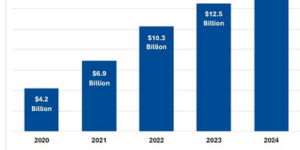With reports of significant reserve strengthening becoming a distant memory and reinsurance providing stability to underwriting results, QBE Group reported its best overall combined ratio result in five years for 2015—6 points under breakeven.
Contributing to the overall group result, QBE’s North American operations reported a 99.2 combined ratio—better than any prior full-year ratio reported for the division since 2011.
While there was a small amount of reserve strengthening ($85 million) in North America related to commercial auto business and late-reported 2014 weather claims, it was nowhere near the $300 million-plus numbers recorded in 2012 and 2013. And QBE Group recorded a $147 takedown in prior-year reserves overall, for all its divisions taken together. According to Group Chief Financial Officer Pat Regan, the group has now recorded three consecutive half-year takedowns of prior-year reserves.

Photographer: Ian Waldie/Bloomberg
“First and foremost, we are and will remain an underwriting business. So we were delighted to pull all of our divisions into profit, record a solid combined operating ratio and actually begin a period of managed, considered growth,” said John Neal, Group CEO, during an investor conference Tuesday.
North America, the largest division of QBE (representing roughly one-third of the group’s $15.0 billion of overall premiums) is a case in point. The North America division’s 99.2 combined ratio for 2015—translating to a $30 million underwriting profit—compares to a 100.8 in 2014 (a $38 million underwriting loss) and a 111.5 combined ratio in 2013.
While overall gross premiums in North America fell 7 percent last year, partly reflecting the sale of the mortgage and lender services business (to National General, completed in October 2015), the North America specialty lines business “actually grew by over 25 percent for the second year in succession,” Neal reported. Corrective underwriting actions on some programs and a tough rate environment in standard commercial business also worked counter to the rise in specialty writings.
A full financial report released for QBE Insurance Group Limited this week states that the North America specialty lines business “remains focused on organic growth of existing lines and entry into targeted new lines which are expected to enhance both portfolio balance and underwriting results over time.”
Noting that U.S. specialty’s gross written premium actually increased 32 percent in 2015, the report says that higher retention and strong new business drove growth across management liability and professional lines, aviation, trade credit and surety, while transactional liability and inland marine as well as a new medical stop loss product were added to the product lineup.
Quoting David Duclos, the CEO of North America, the report says North American operations “turned a corner in 2015” with the first posted underwriting profit since 2011. “With portfolio remediation largely behind us, the development of an operating model to support profitable growth and ‘go to market’ capabilities is progressing,” he added.
Speaking more broadly about the group overall, Neal said in introductory remarks written in the report that “2015 was a year of transition, closing off our remediation phase and beginning our return to profitable growth.”
As for North America, in particular, he said, “We are very confident that our North America operations will improve further this year—and indeed actually continue to grow.”
Hitting the Mark; Reinsurance Helps
Speaking at the investor conference, Neal said simply that “underwriting hit the mark” in 2015, as he talked about a 94 combined ratio for the group, down from 96.1 in 2014, and a 34 percent jump in underwriting profit to $731 million. (Editor’s Note: The figures are adjusted to exclude the impact of Argentine workers compensation business sold last year. Including that business, the reported combined ratio is 94.9, still lower than any prior result since 2010.)
Neal and CFO Regan both noted that good fortune in the U.S. crop business was a major contributor to overall results, referring to the 84 combined ratio achieved for the business as “a market-leading result.” But it wasn’t just strong yields, good growing conditions or stable corn and soybean prices that drove profits higher.
“We smartly bought reinsurance to improve the predictability and quality of the North American crop business,” Neal said.
Beyond the crop book, the two executives also repeatedly referred to groupwide aggregate reinsurance protections that contained the costs of large individual risk claims and catastrophe claims to less than 9 percent of earned premium. “This program has been renewed unchanged and in full for 2016,” Neal said, but he suggested that all of QBE’s reinsurance purchases will get a thorough review later this year in an effort to lower group expenses.
“We have engineered all of our reinsurances to expire on one date—Jan. 1, 2017. This is allowing us to think about reorganizing our purchase, program design and our strategies where we think can drive further efficiency and indeed reduction in spend without taking significant further risk,” he said.
Later asked whether QBE would change the aggregate cover or reinsurance protections for the crop book, Neal referred to the need to move more lines of business covered by independent reinsurance treaties into consolidated programs.
He noted that QBE spends over $2 billion on reinsurance protection ($2.5 billion including cessions to the U.S. government on crop). “We’ve done a good job in consolidating a number of our placements, but we still buy different treaties for our inward reinsurance [QBE Re], crop, lenders mortgage in Australia, marine.” Noting that QBE also buys facultative reinsurance, he said: “There are an awful lot of independent purchases where we don’t think we’re as efficient as we could and should be. So by taking a holistic look at all of our reinsurance buying, our sense is that we could save as much as 10 percent,” he said, adding that the lower spend would also have a beneficial impact on net earned premiums.
As for crop, in particular, Neal noted that QBE may have actually bought too much reinsurance in a year that turned out to be a good one. “I’d rather sit in front of you and say we overbought our reinsurance a little bit but are outperforming than the other way around,” he said, also noting that that analytical approach to risk selection—analysis by state, by county, by farm, by crop and by field—helped results.
Neal and Regan said that other expense-cutting exercises will continue at QBE as well. “A strict rhythm of cost control will see us take out another $150 million of costs in 2016,” reducing the expense ratio by roughly 1 percent, Neal said reviewing the outlook for the year.
Already, an operational transformation program started three years ago, together with added savings achieved from “the right-sizing of the North American operations,” has generated nearly $400 million in cost savings. The figure includes a further $126 million of incremental benefits in 2015, Neal said.
In 2016, the cost reduction program in North America reduced controllable expense by about $80 million, Regan said.
Looking out at the next three years, QBE is developing plans to eliminate a further $150 million of costs in 2017 and 2018, Neal said.
While cutting expenses in some areas, Neal repeatedly highlighted the fact that QBE is making substantial investments in its claims management systems to improve the cost of claims indemnity and reduce the cost of managing claims while improving customer service capabilities. Like the reinsurance spend, investments in the “claims transformation project” are intended to stabilize the claims ratio, even as the market softens.
Neal noted that elements of the claims transformation project are being used in all divisions already, with an initial focus on fraud management, supply chain effectiveness and a heightened use of real-time data and analytics (managed from QBE’s own dedicated centers in Manila and India).





















 Wildfire Losses Increasing But Still Small Compared to Hurricanes: KCC
Wildfire Losses Increasing But Still Small Compared to Hurricanes: KCC  Federal Bill Reintroduced to Combat Organized Retail Theft
Federal Bill Reintroduced to Combat Organized Retail Theft  Performance Review: Why Insurers Struggle to Underwrite, Price and Reserve for Commercial Auto Risks
Performance Review: Why Insurers Struggle to Underwrite, Price and Reserve for Commercial Auto Risks  Insurers Need End-to-End Strategy to See Double the ROI in AI Implementation
Insurers Need End-to-End Strategy to See Double the ROI in AI Implementation 




